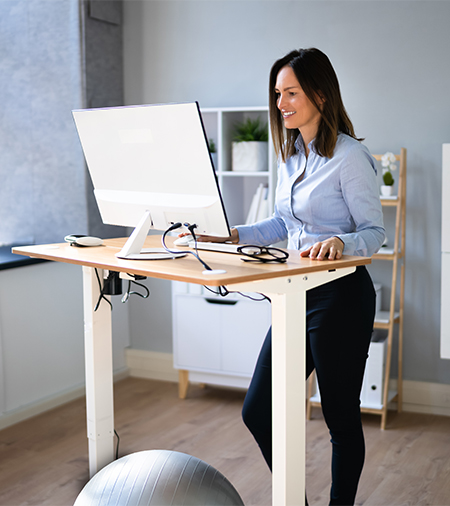If you spend most of your day at a desk, you risk developing pain and injuries.
 Whether you work in an office or at home…
Whether you work in an office or at home…
We all agree that most of us would be lost without computers. When computers are down, businesses shut down. So, computers aren’t going away anytime soon.
But sitting for long periods can cause pain and injury in the neck and back. This can be caused by or exacerbated by poor posture, high repetition, and sustained positions of the joints.
Musculoskeletal disorders like carpal tunnel syndrome, trigger finger, neuropathies, and tennis elbow can develop when you repetitively type or use your mouse. They form when your setup is not working for you and your arms are in awkward positions. These conditions can all start gradually with mild pain or numbness/tingling until they worsen to the point where your job seems impossible to complete.
Your office space may also have other obstacles to navigate that could be causing you harm, such as reaching overhead or frequent phone use. A poor setup that requires you to reach outside your primary work zone or hold a phone for long periods can pose hazardous health risks.
If left untreated, an initial mild pain can become a full-blown injury that requires weeks to months to recover from and can stop people from being able to work. Many go out on disability while they recover. The key is to prevent these injuries from occurring in the first place. This often requires a few simple adjustments to your workspace and habits.
 We have to learn to live with them and adapt.
We have to learn to live with them and adapt.
But instead of adapting to a less-than-ideal computer workstation, your computer workstation should be adapted to you.
That’s where ergonomics comes into play. Ergonomics is the science of workspace design for comfortable and efficient use.
Modifying something in your environment, such as your chair, can eliminate the aches and pains you may have been having. And if you’re already experiencing pain, it can reduce the chance of the pain worsening and becoming a chronic injury.
Make modifications to your desk workstation BEFORE pain begins. You can prevent many injuries commonly experienced by people working at a desk for long periods.
Whether you’re in pain or trying to prevent it, ergonomics is important!
You might be wondering if your desk is set up right for you…
The placement of your hands relative to the desk can mean a world of difference to your wrists. You risk excessive wrist flexion, potentially causing carpal tunnel syndrome, if they are too high. You risk excessive wrist extension, potentially causing tennis elbow if they are too low. This is true for all other risky areas of your body, including the head/neck, back, hips, knees, and ankles.
If your workstation isn’t set up for YOU, there are many things you can do to prevent or reduce common injuries.
Often, a few tweaks to your workspace is all that is necessary. For example, sometimes raising the height of your monitor and lowering your keyboard re-align your neck and wrists. In other cases, ergonomic equipment may be necessary. But as an honest person, I will not recommend any expensive ergonomic equipment right off the bat if this is not necessary.
 But you need a professional to help you get it right.
But you need a professional to help you get it right.
We’ll begin with a detailed desk workstation assessment. We can do that virtually or in person if you live or work in Harford County, Kent County, Baltimore County, Cecil County in Maryland and New Castle County in Delaware.
I will ask you questions for the assessment and observe you working at your desk.
I want to know your injury history, concerns, and routines at work. I will look for awkward postures within the neck/back, elbows, wrists, fingers, hips, knees, and ankles. I take a top-down approach to looking at the whole person. I will also see what needs to be changed to reduce the effects of other risks such as high repetition and highly sustained positions.
I will also listen to all your questions and concerns.
Many have questions about whether their mouse is right for them or whether they should invest in an ergonomic keyboard. I can help you make these pivotal decisions on what is right for you in your workspace.
Based on my observations and the information you provide, I will send you a personalized report with tips and recommendations, feedback, and an exercise program tailored to your specific needs. I will give you simple, low-cost solutions to modify your current setup. And, if necessary, I will recommend affordable equipment that meets your budget and specified preferences.
You’re busy, and life is short…
So, don’t waste your time Googling about your workstation, wondering if you’re on the right track.
I’ve done all the work… let me help you out.
Aren’t you ready to be pain-free and productive again?
Contact me for a free consultation to determine if this is the right fit for you: info@chrgtherapy.com.

